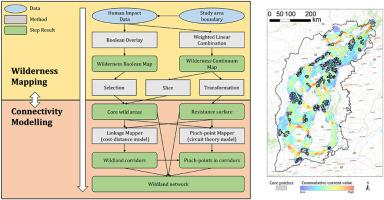当前位置:
X-MOL 学术
›
Biol. Conserv.
›
论文详情
Our official English website, www.x-mol.net, welcomes your feedback! (Note: you will need to create a separate account there.)
Linking wilderness mapping and connectivity modelling: A methodological framework for wildland network planning
Biological Conservation ( IF 5.9 ) Pub Date : 2020-11-01 , DOI: 10.1016/j.biocon.2020.108679 Yue Cao , Rui Yang , Steve Carver
Biological Conservation ( IF 5.9 ) Pub Date : 2020-11-01 , DOI: 10.1016/j.biocon.2020.108679 Yue Cao , Rui Yang , Steve Carver

|
Abstract Habitat fragmentation is one of the key drivers of global biodiversity loss. In this context, connectivity modelling is increasingly important for effective conservation. Most previous studies on connectivity modelling are based on focal species, while fewer studies focus on models based on landscape naturalness or wildness. We propose a methodological framework for wildland network planning, which utilizes the results from wilderness mapping as input data for connectivity models. The least-cost model and circuit model are applied using Linkage Mapper and Circuitscape, with wilderness areas selected as source patches together with resistance values transformed from a wilderness quality index. Taking the Great Taihang region of China as an example, wildland networks are created and pinch-points are identified. We show that the selection of core patches and resistance surfaces have a significant impact on the resulting corridors. The wildland network could serve as an effective and efficient alternative to habitat network and supplement the protected areas network, especially when the species distribution data are lacking, or a rapid assessment is required. This framework for wildland planning could potentially be applied to fragmented landscapes across various countries to eliminate or reduce the negative impacts of habitat fragmentation on biodiversity.
更新日期:2020-11-01



























 京公网安备 11010802027423号
京公网安备 11010802027423号